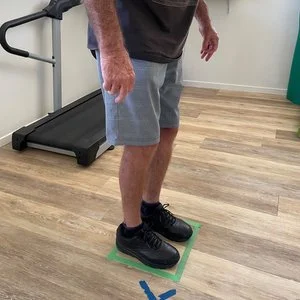Perturbation-Based Balance Training
balance training with a physiotherapist
Our brains use information from three balance systems that allow us to sit, stand, walk and move every day without falling.
Somatosensory/ Proprioceptive System: provides information from our skin, joints and muscles on where our body is positioned in space and the surfaces we are standing on
Vestibular System: a complex system in our inner ear that provides information on the position and movement direction of our head in space
Visual System: our eyes provide information of where we are and the world around us
There are many different types of balance training and a physiotherapist will choose a method depending on the results of your assessment and your goals. Neuro Junction physiotherapists may work to assist with static balance (balance whilst maintaining a stationary position) and/or dynamic balance (your ability to remain standing and stable while performing movements or actions that require moving oneself).
What is Perturbation-Based Balance Training?
Perturbation-Based Balance Training is a type of training that requires you to react in order to maintain your balance and prevent a fall. Physiotherapists use equipment and exercises that simulate real life scenarios in order to elicit rapid postural responses. For eg. obstacle courses, destabilising perturbations applied to your body or the surface you are standing on such as wobble boards. At Neuro Junction we have a Rehab Gait Training Device which utilises body weight support in a harness for safe practicing of pertubation based training.
There are two type of perturbations used in training:
Internal perturbation: can include you speeding up, slowing down, turning around, sudden stop starts etc.
External perturbation: can include people pushing or pulling you in any direction, obstacles that are stationary or pop-up at different times, or changes in surfaces - slippery, soft, bumpy etc.
A perturbation requires the person to perform a recovery action to remain balanced. These reactions are the positive outcomes for our training!
Recent studies have shown that skills such as reactive postural control and recovery reactions, obtained during a single training session can be retained for up to 1 year! However, it is important to keep practicing in different contexts and environments to make sure you are able to adapt in any situation. This type of training is particularly beneficial for community dwelling older adults or those with high falls risks and in certain neurological conditions such as Parkinson’s disease and Stroke.
Safety first!
There are inherent risks involved in any type of balance training – as we are trying to simulate situations where one might fall. It is important to not try this at home by yourself or with any untrained individuals. Physiotherapists are trained to calculate the risk for each exercise and they have experience in setting up the task so that the risk is minimised. Your physiotherapist will be able to modify each exercise according to your needs and function.


